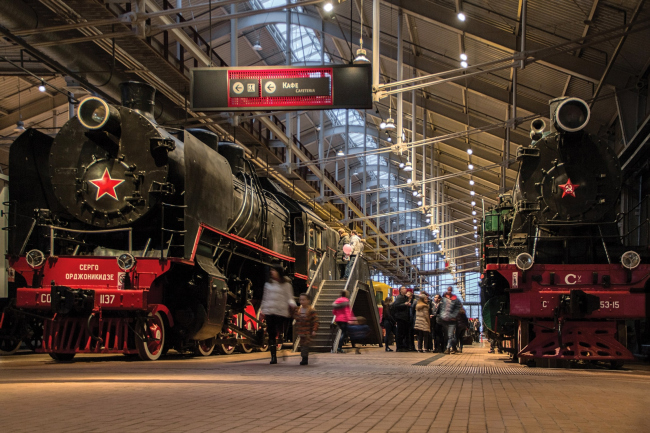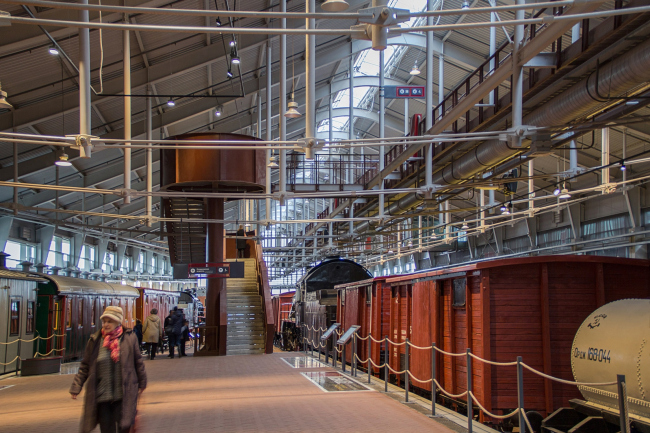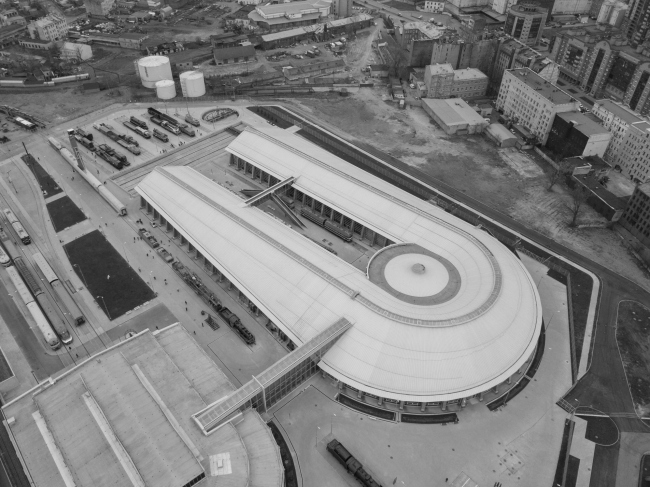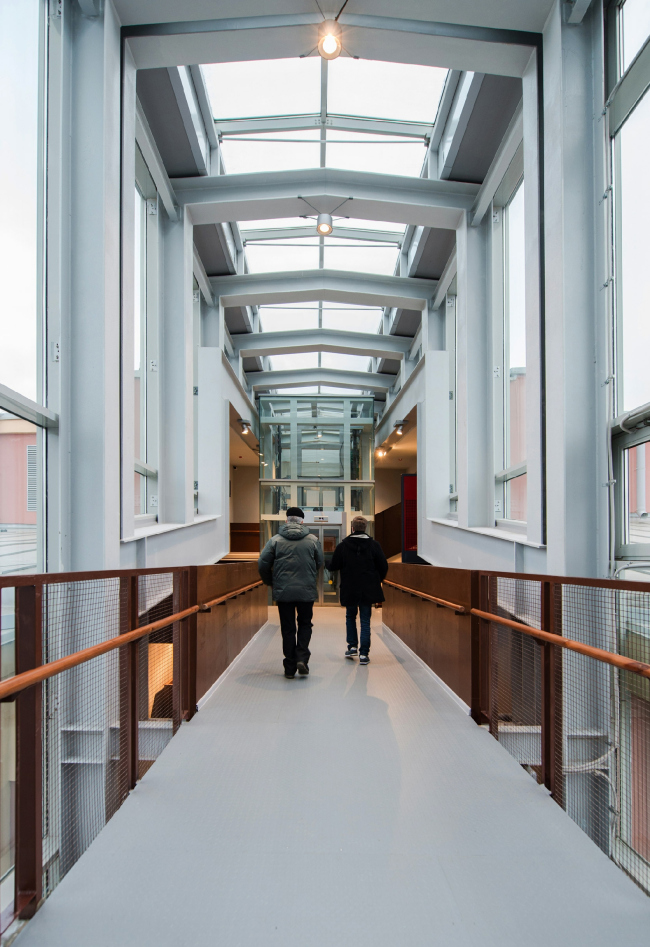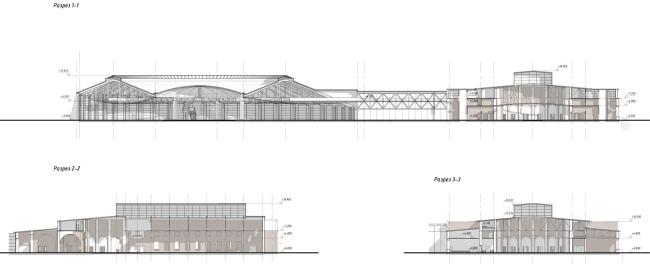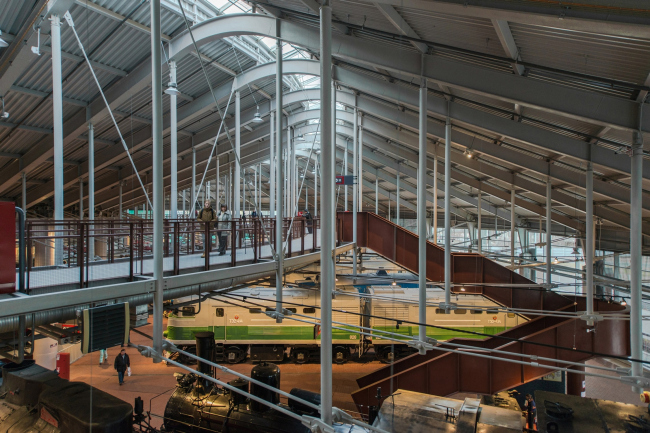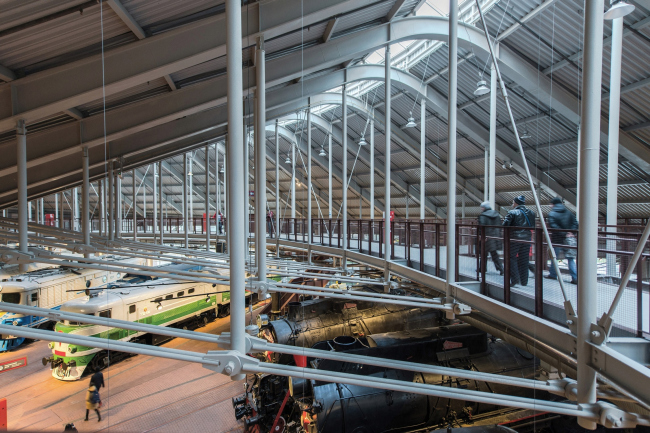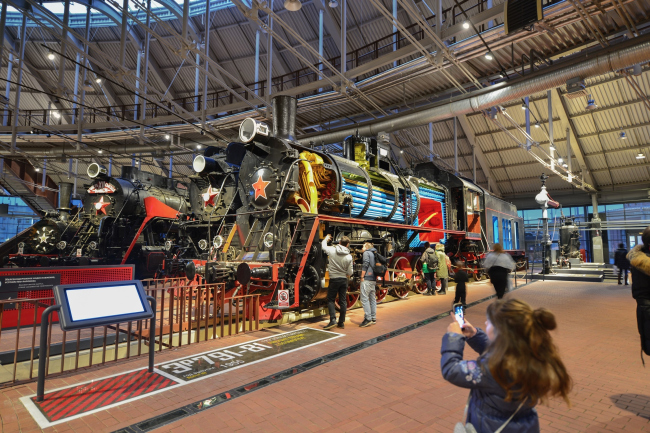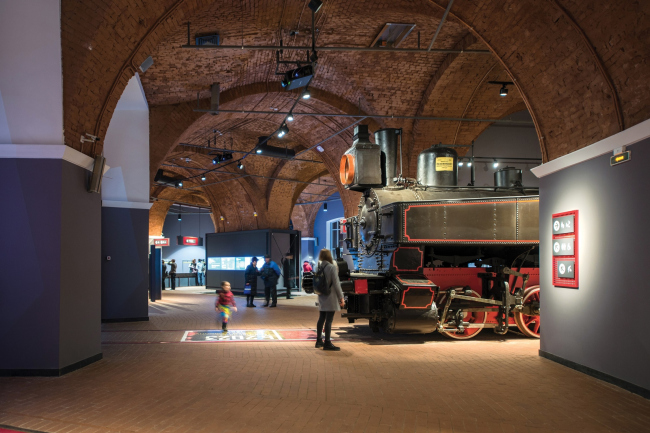|
Published on Archi.ru (https://archi.ru) |
|
| 06.02.2018 | |
|
Postindustrial Attraction |
|
|
Elena Petukhova |
|
| Studio: | |
| Company: | |
|
In the Russian Railway Museum, the architects of “Studio 44” were able to create a powerful and impressive space for a collection of more than a hundred of vintage steam engines and locomotives. The Central Museum of the Oktyabrskaya Railway © Studio 44The technical need In a paradoxical way, this postindustrial epoch is leaving its mark on the urban construction and the mentality of the urban people. The industrial parks are falling into oblivion together with all of their infrastructural attributes to be replaced by the new market “leaders” – housing projects and public complexes that are in an acute need of locations close to the downtown area. And, while the city is ever more actively ousting its industrial facilities, its people start feeling a little bit nostalgic for their material and technical artifacts. The modern technologies and the ergonomic minimalist devices lack the rough, yet, at the same time, luxurious and even “arty and crafty” perfection of their predecessors created in those days when conquering yet another frontier of knowledge and inventing a new device was almost a miracle, and the use of their benefits gave people hope for the bright future for mankind. Around the world, technology museums enjoy great popularity, drawing crowds of children and adults alike by giving them an opportunity to take a few hours’ trip in time from the epoch of the first cast-iron tools to the future when they will be replaced by their polymer analogs. In Russia, this trend is only beginning to gain momentum. For seven years already, there has been going on the reconstruction of the Polytechnic Museum, which is meant to incorporate all of the latest museum techniques for showcasing machines and technologies. The VDNKH is soon opening the Space Museum. These are but some of the large-scale projects that are meant to satisfy Russians’ yearning for the technical heritage of the industrial era. The Central Museum of the Oktyabrskaya Railway © Studio 44The project of the “Russian Railway Museum” is a vivid example of both trends: one of reforming industrial parks and the other of demand for educational formats for technical expositions. From the moment it was opened in November of 2017, the museum has been demonstrating a world-record turnout: it significantly exceeds the anticipated figures, thanks to which the exposition underwent an express test of being vandal-proof (not all of the exhibits came out unscathed, by the way). The record-breaking waiting lines of 10 thousand people a day only shrank when the museum announced the payable entry during the winter break. The Central Museum of the Oktyabrskaya Railway © Studio 44And as for the implementation of the museum project, it became possible thanks to a deal between the Russian Railways which own huge city territories occupied by railroad lines and railroad infrastructure projects all across the nation, and the developer company “Etalon Group”. The contract provided for handing a part of the land behind the Baltiysky Terminal over to the developer for the construction of “Galactica” housing complex, while in return Etalon Group would finance the construction of the railroad museum. Such a system of mutually beneficial exchange is rather common and has its pros and cons. Among the latter is the minimization of costs allotted by commercial companies for implementation of such “encumbrances” of their projects. To do “Etalon Group” justice, it must be said that the company, although it did not throw its money around, still did not take the mission of building this social and cultural project as some form of a tithe that you cannot avoid but you don’t have to pour your soul into. The Central Museum of the Oktyabrskaya Railway © Studio 44Between the tracks We already gave a detailed coverage of the Russian Railway Museum, which gives us an opportunity to limit ourselves to but a brief description of the main project solutions. The railroad museum has existed in Saint Petersburg since 1978, and over the last few years it has changed several locations, following the changes of the town planning and market policies. At the last turn in its history, which happened in 2012, the Russian Railways collection (which consists of a whopping hundred-plus locomotives and train cars of the XIX-XX centuries) was allotted a part of the territory of the former locomotive depot next to the Baltiysky railway station. When it was invited to design the museum, “Studio 44” proposed to keep intact the authentic depot, making it a part of the new exhibition complex. The Central Museum of the Oktyabrskaya Railway. Plan © Studio 44The structure of the old building – a hoof with a turntable in its center, equally suitable for the older functions and for solving the exhibition tasks – was repeated on a greater scale, where now most of the steam engine collection stands. As for the old building, it incorporates the service functions, such as a lobby, a café, a souvenir shop, a conference hall, a management section, and a few exhibition halls devoted to Russia's first railroads (Tsarskoselskaya, Warsaw-Wien, Saint Petersburg-Moscow, etc). And, as for the first floor of the depot, they will showcase the oldest exhibits, including the Stephenson steam engines. The Central Museum of the Oktyabrskaya Railway. Plan © Studio 44The two buildings are linked by a glass overpass running at the level of the second floor. The railroad tracks running between these two buildings also serve to demonstrate part of the collection that is impenetrable to the vagaries of the Saint Petersburg weather. The Central Museum of the Oktyabrskaya Railway. The passage between the new and the old buildings © Studio 44The Central Museum of the Oktyabrskaya Railway. The open-air exposition © Studio 44Each of the elements of the museum ensemble and each fragment of its buildings is one way or another determined by the railroad specifics. At some places, you will see but a fleeting hint at the connection to the railroad theme, and you will have to look real hard in order unravel the mystery. For example, the design of the minor architectural forms of the museum uses railway sleepers, while the navigation posts are based on the rail profile. At some places, on the other hand, this interconnection is most direct, not to say strictly regulated. The museum is a structural subdivision of the Oktyabrskaya Railway, it formally belongs to the Russian Railways, and it is subject to the same system of rules and regulations, some of which have logical grounds, and some of which had to be taken as “givens”. The former is represented by the problem of the railroad tracks direction. The thing is that the coordinate system of the preserved building and neighboring streets did not coincide with the direction of the railroad tracks, by which new “exhibits” would arrive to the museum. The difference was not that great – literally five degrees – but initially it looked insurmountable. Trains, just like chess pieces, can only move in a certain way, and the tracks can only make turns of one certain angle, namely, that of the railroad switch. “No "special technical conditions" reasoning or arguments that the new engines would arrive most frequently but once a year could solve this problem for us. We had two options to choose from. We either had to position the building diagonally – but then it would be unclear how to bring the locomotives to the old depot, turntables or special carts being of no help, or we could leave the complex standing within the coordinates of the street and the existing depot, and lay down the tracks at an angle, so that they would come to the corner of the new building. We chose the second option, and we ultimately came up with a very interesting "scheme"” – Nikita Yavein comments on one of the main challenges of the project and at the same time the main reason for the unusual design of the roof of the new building that became as much as the “visiting card” of the entire project.  The Central Museum of the Oktyabrskaya Railway © Studio 44The Central Museum of the Oktyabrskaya Railway. Facades © Studio 44The Central Museum of the Oktyabrskaya Railway. Section view © Studio 44The crest of the double-pitched roof at the straight sections of the hoof-shaped building runs at an angle, which yields slanted slopes, while in the rounded part the roof forms a bold crease, enhanced by a row of triangular pylons standing outside the stained-glass window and supporting the whole upper structure. The Central Museum of the Oktyabrskaya Railway. Pylons of the new building © Studio 44The Central Museum of the Oktyabrskaya Railway. View of the new building from the transporter side © Studio 44In order to distribute and arrange the “exhibits”, the architects had to install a transborder (also known as “traverser” or “transfer table”) in front of the new building that allows the locomotives and train cars to be moved sideways with the help of crosswise rails and special carts moving on them. Such a dual system of coordinates and a slanted roof were necessary for creating, inside the new building, an extra viewing tier – a bridge-like structure running above the exhibits. The pedestrian bridges, together with the suspensions and trusses that fasten them to the large-span girders, are the indispensable part of the coverage structure that ensures its strength and rigidity. “These bridges do not just hang there – together with the girders, they are part of the bearing framework. If you take them out, the building will fall apart – Nikita Yavein explains – But what is still more important than their construction role is the fact that they make the coverage structure habitable”. The Central Museum of the Oktyabrskaya Railway © Studio 44The Central Museum of the Oktyabrskaya Railway. Interior of the reconstructed depot © Studio 44In the first case, wandering among the rows of locomotives, a person quickly stops feeling like the “apex of creation”, wondering about the triumph of technical thought over the humanitarian values. But once you climb a little bit higher and cast your eye over the entire space of the main exhibition hall, you immediately recall getting acquainted with your first toy railway as a child, in which tracks would meander between model stations, you being the master of a small toy engine and a couple of cars. It’s funny but among all the photos made by amateurs and professionals alike the top angles enjoy particular popularity. The Central Museum of the Oktyabrskaya Railway © Studio 44The Central Museum of the Oktyabrskaya Railway. Interactive model of a steam engine © Studio 44In addition to the therapeutic effect, the top tier shows to the best advantage the ingeniously designed space of the museum, as well as the merits of architectural and engineering solutions. The Central Museum of the Oktyabrskaya Railway. The central turntable of the new building © Studio 44The thorns of realization The inner space of the museum is ruled by steam engines, locomotives and train cars. Their glossy multicolored bodies form a chaotic kaleidoscope-like picture, which, upon closer inspection, demonstrates a neatly organized sequence of the museum exposition (chronological as well as typological), filled with all the state-of-the-art tools for attracting and enchanting the young and grownup visitors. The Central Museum of the Oktyabrskaya Railway. Exposition in the halls of the old depot © Studio 44One should do justice to the exposition designers: they got real fancy and provided for options capable of satisfying the most demanding taste. Here you can take a close look at the models of the first steam engines and even put them in motion. Or look into the eyes of the transportation minister and examine the papers on his table. Next to the models, there is a real-life engine, only it is sliced lengthwise, thanks to which the visitors can examine the engine’s insides where the steam pushes the plungers that make the wheels spin. Here one will also see other simple and interactive exhibits that will evoke in each visitor thoughts about changing his or her career and becoming an engineer or at least a conductor of a long-distance train. The Central Museum of the Oktyabrskaya Railway. Children's zone © Studio 44Architecture is no match for such a powerful opponent, especially so if we are to consider the financing specifics of this project. Here’s how Nikita Yavein comments on the situation with the project implementation: “This museum is the first case in my practice when the implementation of the architectural and engineering part was financed almost in the same amount as the museum work itself. We had to work in the conditions of dire economic constraints in order to meet the budget of less than 1.5 B rubles, which, although this may sound like a lot of money, is not such a great amount for a 20 000 square meter project that also includes restoration of the historical building of the terminal”. However, even in this situation one can easily see that a lion’s share of the exhibition's success belongs to the architects. The experience that “Studio 44” has in designing museum complexes and transport infrastructure projects helped the designers to address a lot of challenges while still in the concept stage, which allowed them to create an exposition of one of the best railway museums in Russia and the whole world. The thought-out planning, the two-tier system of viewing the exhibition, the optimum-style architectural and engineering solutions, which do not conflict with the brutalist exhibits but rather complement them - all of this was initially put into the project and then implemented with the best quality possible under these conditions. Two in one For an architectural firm, just as for any creative team, it is often difficult not to fall for the temptation of specialization. You do a successful project or two – and then you get a crowd of clients standing in line for getting a success guarantee, even if it comes at a price of sacrificing some of their identity. However, going beyond the framework of what’s offered is a risk that ultimately pays off in terms of greater creative freedom and new possibilities. The whole history of “Studio 44” can serve as an example of resisting the “specialty” temptation. Today, it's practically impossible to tell just what exactly the firm's specialty is about. Its portfolio includes tens, if not hundreds, of projects, many of which refer to reconstruction projects in a historical environment, but the portfolio is not limited to this specific kind – there are also town-planning concepts, housing projects, transportation infrastructure projects, cultural centers, museums, and whatnot. Such a broad range gives the team an advantage, letting it use the accumulated knowledge and combine the typologies in order to break beyond the limits of stereotypes. The latter is exactly the case with the museum built upon the project by “Studio 44” for the Russian Railways in Saint Petersburg. In this project, the architects were able to combine their experience of designing railway terminals (in Saint Petersburg, Sochi, Tuapse, Astana and other cities) with the practice of developing concepts for such top-class museums as the Hermitage (the Joint Staff), the Museum of the Defense and Siege of Leningrad, and the Museum of the History of Kazakhstan. The railroad infrastructure is a special genre that paradoxically combines the brutalism of the powerful structures and total submission to the laws of the tracks laid down once and for all with the inevitable literary and romantic connotations. And, in order to create the museum of a railway network, you need to let inside all of its power and all of its poetry, and then come up, based on a thought-out museum exposition scenario, with a just as powerful and bright architectural casing, capable of existing on a par with its contents and even enhancing the visitors” museum experience by giving them an opportunity to see the seemingly familiar world from a whole different angle. The Central Museum of the Oktyabrskaya Railway © Studio 44The Central Museum of the Oktyabrskaya Railway © Studio 44The Central Museum of the Oktyabrskaya Railway © Studio 44 |
|
